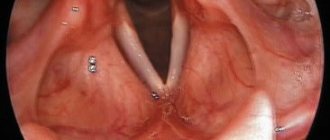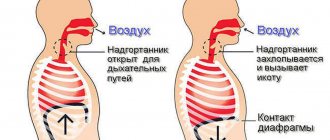Definition
Hiccups are periodically occurring involuntary myoclonic contractions of the diaphragm with possible involvement of the intercostal muscles (usually unilateral). The contraction results in a sudden inhalation followed by closure of the glottis, which is accompanied by a characteristic sound.
Duration
Short-term – up to 48 hours; long-term – from 48 hours to 1 month; intractable – more than 1 month.
Prevalence
Prolonged, difficult-to-control hiccups are quite common in patients with advanced cancer.
Anatomy and pathophysiology
The physiological mechanism of hiccups remains unclear. The hiccup reflex arc includes:
- afferent pathways: phrenic and vagus nerve pathways, sympathetic nervous system;
- diffuse “hiccup center”: midbrain, brain stem, proximal cervical spinal cord (C3 – C5);
- central neurotransmitters: dopaminergic and gamma-aminobutyric acid (GABA);
- efferent pathways: diaphragmatic, vagus and intercostal nerve pathways, conducting signals that cause contraction of the diaphragm.
Common causes of hiccups
The content of the article
As a rule, hiccups appear unexpectedly and last for several minutes.
Most often it is a consequence of poor eating habits. It occurs when we eat in a hurry, greedily swallowing large, unchewed pieces of food.
In such a situation, a lot of air is swallowed and the quickly filled stomach stretches and begins to put pressure on the diaphragm, and this is the most important respiratory muscle that separates the lungs from the abdominal cavity.
Eating too cold, hot or spicy foods also contributes to the occurrence of hiccups. It is worth mentioning large volumes of carbonated drinks. When they are consumed, a significant amount of carbon dioxide accumulates in the stomach.
Often, hiccups appear after drinking alcohol. It irritates the nerve endings of the diaphragm, relaxes the muscles of the throat and stomach. Carbonated drinks can also cause a similar effect, especially when drunk quickly. If after the above types of drinking or eating on the go, frequent hiccups begin, it is worth changing bad habits.
Prolonged hiccups and additional symptoms
When an attack of hiccups lasts more than an hour, is accompanied by pain in the chest or stomach and is repeated daily, go to the hospital immediately. Under the guise of ordinary hiccups, heart attacks, strokes and serious diseases of the gastrointestinal tract can be hidden. The condition may also be accompanied by heartburn and difficulty swallowing.
In addition to the above treatment methods, an operative type of therapy has been developed, which is more often used in the presence of anatomical causes of the pathology.
Specific causes of hiccups
When we eat too much food, we feel sleepy and begin to lie down on the bed. In this case, you should not sleep on your right side. Because then the diaphragm additionally shifts, the airways work worse, and this contributes to hiccups. After a hearty lunch, it is useful to take a walk rather than doze off on the couch.
The cause of this embarrassing illness is chronic stress. When we are nervous, the heart beats faster, breathing becomes irregular, and the diaphragm does not work rhythmically. In such a situation, using infusions of sedative herbs, for example, lemon balm, valerian, and St. John's wort, can help. Sometimes a prescription anti-anxiety or anti-depressant medication may be needed.
Hiccups that recur several times a month or a week and are not relieved with home remedies may be a signal of illness.
Most often, hiccups are caused by problems with the digestive system.
Hiccups can be a symptom of inflammation of the stomach lining or gastroesophageal reflux, when stomach acids irritate not only the throat and esophagus, but also the nerves of the diaphragm.
Other diseases that hiccups may indicate are stomach ulcers or even abdominal cancer. Sometimes a symptom may indicate lesions of the lungs or mediastinum. If the doctor suspects a serious cause, he will refer the applicant for appropriate research.
General principles of treatment
The use of medications is justified in cases of prolonged attacks. When prescribing antipsychotics, use drugs that do not have hypnotic or sedative effects. Antidepressants, in addition to relieving muscle spasms, improve the functioning of the nervous system.
The main causes of illness in children are identical to attacks in adults:
- Overeating – normalize the child’s diet.
- Stress, fear - normalization of the environment, if necessary, consultation with a psychotherapist.
- The presence of a disease of the digestive tract, nervous system or respiratory system - finding out the cause and curing it under the supervision of a doctor.
Classification
The main criteria used in systematizing the variants of hiccups are its connection with pathological conditions, development mechanisms, and duration. In most cases, hiccups are physiological in nature and are not associated with any diseases. Diaphragmatic myoclonus is called pathological, occurring against the background of various diseases and presented in such forms as:
- Central hiccups
. It is caused mainly by disturbances in the brain regulation of diaphragmatic contractions. It is observed in cases of inflammation, tumors and injuries of the brain and spinal cord. It is possible to develop hiccups with functional disorders of the central nervous system. - Peripheral hiccups
. Associated with damage to various parts of the phrenic and vagus nerves. Characteristic of volumetric processes in the mediastinum, diseases of the chest and abdominal cavity adjacent to the diaphragm. - Referred hiccups
. It is provoked by pathological conditions in organs located outside the zone of innervation of the vagus and phrenic nerve. It can be observed against the background of enteritis, colitis, helminthic infestations and diseases of the female reproductive system. - Toxic hiccups
. It becomes a consequence of poisoning of the nervous system with endo- and exotoxins. It is detected in case of poisoning with mushroom poisons, alcohol and medications (anaesthetics, drugs), uremia, diabetic coma, terminal conditions.
Physiological hiccups are usually short-lived. With pathological contractions of the diaphragm, there are episodes of transient hiccups (from several minutes to several hours), persistent hiccups lasting more than 2 days, and long-term hiccups (from a month or more). Although usually prolonged hiccups indicate the presence of pathological conditions, in rare cases it can be observed in a healthy person.
Frequently asked questions about hiccups
How to stop hiccups?
To get rid of it, you can slowly drink a glass of cool water, eat something sour (a slice of lemon, for example) or sweet (a spoonful of honey), and do breathing exercises.
Which drug is effective?
Unfortunately, there is no medicine yet that would help for the shortest possible period of time. You can take an over-the-counter digestive aid.
Which organ is responsible for hiccups?
The mechanism of this disorder involves the diaphragm and intercostal muscles.
Hiccups are common and usually occur accidentally. Only in the presence of multiple or prolonged episodes of hiccups, or singultus, is considered pathological. It is unknown whether it plays a physiological role. (End. Start of material here.)
Etiology
Hiccups can be classified based on their duration. Lasting more than 48 hours is classified as persistent, more than 1 month - indomitable.
Hiccups are mediated by a reflex arc consisting of afferent vagus, phrenic and sympathetic nerves centered in the brainstem, efferent nerves to the diaphragm muscles and intercostal muscles. It can be caused by pathology or irritation of one of the branches of this reflex arc. Some facts have been well documented. For example, hiccups caused by a stroke disappeared after treatment with anticoagulants. Successful outcome after therapy for meningitis has also been described (Mandalà M. et al., 2010; Delèvaux I. et al., 2005; Sugimoto T. et al., 2008).
It is not only damage to the relevant nerves that can cause hiccups, but also a suprathreshold stimulus. For example, distension of the esophagus or stomach by air, food, consumption of hot liquids, as well as gastroesophageal reflux and angina (Fass R. et al., 1997; Pooran N. et al., 2006; Redondo-Cerezo E. et al., 2008; Kobayashi Z. et al, 2009). It has also been described that hiccups developed in patients with esophageal cancer after esophageal stent placement, bronchoscopy, gastroscopy and during electrical stimulation of the left atrium (Turkyilmaz A., Eroglu A., 2008; Doshi H. et al., 2008). Prolonged hiccups can be caused by a foreign body in the ear, present with neck tumors, neurological disorders, diabetes, uremia, alcoholism and inflammatory or neoplastic processes in the chest such as tuberculosis, pleurisy and cancer. Gastrointestinal causes include GERD and partial gastric obstruction.
Causes of uncontrollable hiccups
♦ Peripheral nerve stimulation
Gastrointestinal:
- stomach ulcer, stomach distension,
- pancreatitis, cholecystolithiasis;
cardiovascular:
- myocardial infarction,
- pericarditis;
local compression of the nerve:
- mediastinal lymph nodes,
- abscess,
- instrumental (intubation, catheterization, stents);
local nerve infection (herpes);
pulmonary:
- pneumonia,
- asthma,
- lung tumors.
♦ central nervous system
- Vascular diseases
- tumor,
- inflammation,
- injury,
- infection,
- uremia.
♦ System factors
- Medicines and drugs
- electrolyte disturbances,
- alcohol.
Pathogenesis
Hiccups result from intermittent and forced spasmodic contractions of the respiratory muscles, resulting in audible sounds.
Clinic
In most cases, episodes of hiccups are short and resolve spontaneously. Chronic is defined as lasting more than 48 hours. Prolonged and persistent hiccups can be present for days, months and even years, creating problems of chronic weakness, sleep disturbances, depression, weight loss and even suicide.
Diagnostics
History: other symptoms and their duration, use of medications, drug use.
Physical examination is complete, including ears, nose and throat; neurological assessment.
Laboratory tests include complete blood count, electrolytes, urea, cortisol, amylase, lipase, C-reactive protein, and liver function tests.
Instrumental studies: upper endoscopy, laryngoscopy, ECG, X-ray and/or CT scan of the chest and abdomen. MRI of the brain is the last hope. However, like esophageal manometry and 24-hour impedance and pH measurements, MRI is not always indicated and may be performed if additional symptoms or signs are present. In most cases, the causes cannot be found. Fluoroscopy may be performed to evaluate diaphragm movement.
Treatment
Most episodes of hiccups are temporary and self-limiting and may not require evaluation or treatment at all. When hiccups begin during invasive procedures such as bronchoscopy, gastroscopy or during anesthetic infusion or chemotherapy, the underlying cause is easily identified and treatment should be directed towards it. If the underlying pathology is treatable, the problem can be solved. But sometimes the active factor is not detected.
Common interventions include holding your breath, quickly drinking water continuously, irritating the nasopharynx and esophagus, inflating a balloon, and applying pressure to the eyeballs. Stimulating the throat with a nasogastric catheter on an empty stomach may help. Medications used include baclofen (5 to 20 mg three times daily), metoclopramide, chlorpromazine, haloperidol, amitriptyline, carbamazepine, and nifedipine. In some cases, surgical ablation of the phrenic nerve is used. In infants, stimulation of the latter is carried out by prompt placement of electrodes.
Aerophagia
In this functional disorder, patients swallow air so often and in such large quantities that it causes symptoms. Some of the swallowed air is ventilated through gastric burps, and some reaches the intestines, where it causes bloating.
Clinical symptoms are varied - up to dangerous degrees of stretching of the lumen. Some cases have been described in children with mental disorders where extreme volumes of air swallowed lead to extreme dilatation of the stomach and intestines with subsequent gastric volvulus, ileus and difficulty breathing (van der Kolk MB et al., 1999; Komuro H. et al., 2005 ; Frye RE, Hait EJ, 2008).
Bloating is a common symptom in patients with irritable bowel syndrome, functional dyspepsia, and constipation. But aerophagia is very rare among them.
Physiology
Swallowing air while eating and drinking is a normal physiological act. A study of healthy individuals swallowing 10 ml of liquid showed that 8–32 ml of air were entrained (Pouderoux P. et al., 1996). In an upright position, it accumulates in the proximal stomach. Stretching the arch of the latter causes transient relaxation of the LES, which allows air to escape. Ingestion of drinks containing carbon dioxide provokes belching by the same mechanism (Tew S. et al., 2000). Once the air has passed the LES and entered the body of the esophagus, stretching of the latter leads to relaxation of the LES, which allows air to be directed into the pharynx.
Most people with significant belching believe that it is due to some kind of organic disease. Often patients are convinced that they have unusually high gas production in the stomach or intestines. In individuals with normal cognitive function, aerophagia has been associated with GERD and hiatal hernia, but this association is poorly documented. Chronic aerophagia in children can lead to stretching of intestinal loops with thinning of the muscles of the anterior abdominal wall.
Clinic
Other symptoms include flatulence, abdominal or epigastric pain and constipation. Gastric belching is not usually the predominant symptom, and supragastric belching is generally not observed in patients with aerophagia.
Nuances:
- Aerophagia involves excessive swallowing of air, causing progressive distension of the abdomen. Symptoms in children include a sunken stomach in the morning, progressive bloating throughout the day, visible and frequently audible gasping for air, and excessive flatulence. Resolution of bloating occurs at night as a result of gas absorption and flatulence.
- Pathological aerophagia of childhood is defined as a chronic condition associated with gastrointestinal symptoms such as abdominal and epigastric pain, decreased appetite and belching.
- Aerophagia can not only be chronic, but also occur as an unexpected acute attack.
Diagnostics
According to the Third Rome Consensus, identification of a patient with aerophagia should include at least two of the following criteria:
- swallowing air;
- bloating;
- repeated belching and/or increasing flatulence.
Anamnesis. Aerophagy can be established using a survey. Bloating, belching, flatulence, abdominal distension, constipation, abdominal pain, no vomiting.
Physical examination: increased abdominal tympanitis, normal bowel sounds, no signs of ileus; may be after chewing gum or smoking.
Laboratory tests: complete blood count, erythrocyte sedimentation rate, C-reactive protein, kidney and liver function tests, celiac disease testing, radioimmunosorbent and radioallergosorbent tests, biochemical indicators of iron, calprotectin test, urinalysis.
Instrumental research. X-ray of the abdomen. Intestinal distension, large volume of air in the intestine, lack of gas/liquid levels. Upper endoscopy optional.
The most satisfactory diagnostic criterion is abdominal bloating, which gradually increases during the day (minimal in the early morning and maximal in the late evening), increased flatulence during sleep, and increased bowel sounds on auscultation of a distended abdomen. An x-ray taken at the end of the day shows a distended stomach and an increase in the volume of gas in the small and large intestines without signs of obstruction.
Differential diagnosis from mechanical obstruction can be difficult. About 30% of patients undergo a negative exploratory laparotomy after presentation to the emergency department (Bredenoord AJ, 2013). On retrospective review, abdominal radiographs showed only distended bowel loops but not air and fluid levels, hence no evidence of obstruction. Thus, laparotomy should be avoided in these patients (Bredenoord AJ, 2013).
In irritable bowel syndrome and constipation, an increased volume of air in the intestine may also be found, but there is no increased air swallowing (Bredenoord AJ, 2013).
Treatment
Based primarily on expert opinion as there are no controlled studies. For treatment, it is recommended to differentiate patients with chronic stable symptoms from patients with acute and severe episodes of aerophagia, which can lead to a threatening situation. The latter occurs mainly with mental disorders and can contribute to the appearance of volvulus, obstruction and difficulty breathing due to increased pressure in the abdominal cavity. In this case, placing a nasogastric tube to evacuate air from the stomach seems reasonable, and sedatives such as lorazepam may help reduce re-swallowing (Bredenoord AJ, 2013).
Most patients have chronic symptoms and a different approach is warranted. It is wise to limit your intake of carbonated drinks and eat slowly. Medicines such as espumizan prevent gas from forming in the intestines and may relieve symptoms. In cases of constipation secondary to distension of the small and large intestine, the use of laxatives is indicated (Bredenoord AJ, 2013).
How to get rid of hiccups
The most effective method of stopping hiccups is called breathing into a bag. This is explained by the fact that by saturating the blood with carbon dioxide, we concentrate the vagus nerve on the fact that the body needs a full breath. And this allows you to stop the random sending of signals to the brain, causing the diaphragm to contract in spasms.
The second effective way to get rid of accidentally attacked hiccups is to drink water, standing in a bird pose: fix your arms along your body, like folded wings, and tilt your body forward to reach a glass of water. This requires outside help, because someone has to hold the glass. You need to drink in small sips, stretching your neck.
The third, and most famous method is to take more air into your lungs and hold your breath for as long as possible. In this way, it will be possible to push through the diaphragm with your lungs and keep it in a calm position.
Tests and diagnostics
For diagnosis, it is important to collect an anamnesis, as a result of which illnesses suffered, the presence of head injuries, surgical interventions on the brain and spinal cord, and manipulations are revealed. Triggers that provoke hiccups, medication use, and the patient’s attitude toward smoking and alcohol are identified.
- a full examination and examination by specialists (otolaryngologist and neurologist);
- Clinical and biochemical blood test (electrolytes, C reactive protein, urea, creatinine, amylase, liver tests);
- MRI of the brain;
- CT scan of the chest;
- electroencephalography;
- esophageal manometry;
- esophagogastroduodenoscopy;
- bronchoscopy;
- spirography;
- Lumbar puncture.
Diagnosis of abnormal breathing
The disease “hiccups” requires a thorough diagnosis of the whole organism in order to establish the cause of this pathological condition. First of all, consultations with a cardiologist and neurologist are prescribed to rule out myocardial infarction and cerebral stroke. The examination usually involves an electrocardiogram and magnetic resonance imaging, respectively.
Depending on the clinical picture, the following studies may be required: radiography, computed tomography, gastroscopy, spirography, electroencephalography, bronchoscopy, esophagomanometry, as well as tests for calcium levels in the blood serum, creatinine content, functional state of the liver, etc.
Sources
- Gou ZP., Zhao YL., Zou LL., Wang Y., Shu SQ., Zhu XH., Zheng L., Shen Q., Luo Z., Miao J., Wang YS., Luo XD., Feng P The safety and tolerability of alkaloids from Alstonia scholaris leaves in healthy Chinese volunteers: a single-centre, randomized, double-blind, placebo-controlled phase I clinical trial. // Pharm Biol - 2022 - Vol59 - N1 - p.484-493; PMID:33899689
- Abbasi J. Data Leak Exposes Early COVID-19 Vaccine Manufacturing Hiccups. // JAMA - 2022 - Vol325 - N14 - p.1385; PMID:33847730
- Martinez Paredes JF., Thompson CC., Rutt AL. Laryngeal Manifestations of Intractable Singultus. // Cureus - 2022 - Vol13 - N3 - p.e13730; PMID:33842108
- Anwar SL., Avanti WS., Choridah L., Dwianingsih EK., Hardiyanto H., Aryandono T. Concurrent manifestations of Horner's syndrome and esophageal metastasis of breast cancer: case report of a young woman after a period of non-adherence to treatment : a case report. // J Med Case Rep - 2022 - Vol15 - N1 - p.194; PMID:33836802
- Alefishat E., Aloum L., Baltatu OC., Petroianu GA. The action of aripiprazole and brexpiprazole at the receptor level in singultus. // J Integr Neurosci - 2022 - Vol20 - N1 - p.247-254; PMID:33834710
- Atiyat R., Veeraballi S., Al-Atiyat N., Chan KH., Slim J. A Rare Case Report of Persistent Hiccups as an Atypical Presentation of COVID-19. // Cureus - 2022 - Vol13 - N3 - p.e13625; PMID:33816024
- Kutuk MO., Berdzenishvili E., Aksu GG. Hiccups in an Adult Case with Schizophrenia due to Aripiprazole: A Case Report. // Noro Psikiyatr Ars - 2022 - Vol58 - N1 - p.77-78; PMID:33795958
- Ikitimur H., Borku Uysal B., Ikitimur B., Umihanic S., Smajic J., Jahic R., Olcay A. Case Report: Two Cases of Persistent Hiccups Complicating COVID-19. // Am J Trop Med Hyg - 2022 - Vol - NNULL - p.; PMID:33793414
- Ehret C., Young C., Ellefson C.J., Aase LA., Jatoi A. Frequency and Symptomatology of Hiccups in Patients With Cancer: Using an On-Line Medical Community to Better Understand the Patient Experience. // Am J Hosp Palliat Care - 2022 - Vol - NNULL - p.10499091211006923; PMID:33792359
- Sawai S., Mori M., Makino T., Nakano Y., Kuwabara S., Kamitsukasa I. Severe orthostatic hypotension associated with lesions of the area postraema in neuromyelitis optica spectrum disorder. // eNeurologicalSci - 2022 - Vol23 - NNULL - p.100335; PMID:33763606
What to do if hiccups still don’t go away?
Lemon will help get rid of hiccups.
Photo: jenoche / freepik.com When your hiccups don't go away, you work hard to make them go away. You focus on your chest and consciously tense your diaphragm. But by straining and trying to suppress the next bout of hiccups you're expecting, you're only making things worse. Below we recommend more correct techniques for you.
- Swallow a small amount of something bitter or sour. When something unusual gets into the digestive system, the cramps usually go away: try sucking on a piece of lemon.
- Try to suppress the hiccups as a reflex. Place your finger on the wall of your throat as if you are about to induce vomiting. However, in reality there is no need to take your actions to such an extent. In this way you can interrupt the established rhythm of hiccups.
- Try drowning out the hiccups with water. Drinking a large glass of water in small sips at a steady pace can help stop hiccups. In this way, food debris is washed away from the lower part of the pharynx and, possibly, their irritating effect on the nerve passing in this area is eliminated.
- Drink water in an inclined position. The upside down position offers a completely new approach to treating hiccups. Bend your torso over the sink and begin to sip water from a glass placed as far away from you as possible.
- Use a sudden startle method, such as startling the hiccup victim with a sudden pop of an inflated bag or a loud shout. This can immediately interrupt the spasm.
- Try the traditional method with thread. Residents of the southern regions of Texas of Spanish origin use a popular method of interrupting hiccups using a red thread or strip of material. They are tied around the child's head in the forehead area at the level of the bridge of the nose. Perhaps the child directs his eyes to the thread and thus switches his attention. And this is exactly what you need to stop hiccups.
- "Sweeten the pill." Sprinkle a little granulated sugar on the back of your tongue and swallow it, you can stir a spoonful of granulated sugar in a small amount of beer and drink this mixture.
- Hold your tongue. The next time you experience hiccups, open your mouth wider, take your tongue, pull it slightly and hold it for a few seconds. This method of treating hiccups was preferred by President Kennedy's personal physician.
- Bet on money is a favorite remedy of some doctors, which they say has never failed in cases of common hiccups. When someone starts to hiccup, take out the money, put it on the table and make a bet with that person that he or she will not be able to hiccup in the next minute. This person will not be able to truly hiccup another time without losing the bet.
You can stop hiccups by drinking water in an inclined position.
Photo: goffkein / freepik.com Once you stop trying to stop the hiccups, a whole set of other muscles come into play and the cramps disappear.







